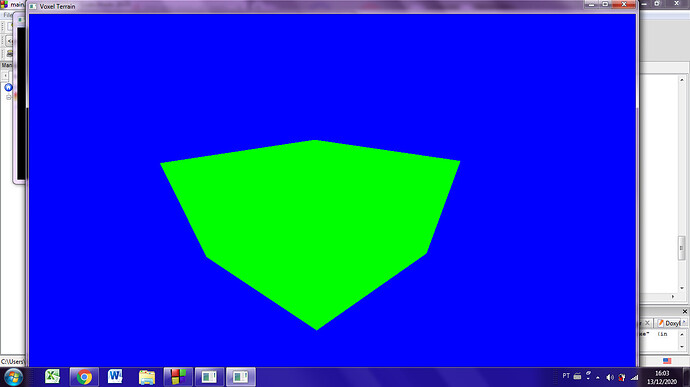Hey guys! I am new here, and i want make a voxel terrain in c++ with opengl. But i don’t know how to use the fast noise. Anyone can help me?
this is my code:
#include <GL/glut.h>
#include <GL/gl.h>
#include <math.h>
#include <FastNoiseLite.h>
FastNoiseLite noise;
// Camera var
float angle = 0.0; // Angle of the camera
float lx = 0.0, ly = 0.0, lz = -1.0; // Direction of the camera
float x = 0.0, y = 1.0,z = 0.0; // Position of the camera
float deltaAngleX = 0.0, deltaAngleY = 0.0;
float xOrigin = -1.0, yOrigin = -1.0;
// Terrain var
int tx = 10, ty = 10, tz = 10;
void mouseButton(int button, int state, int x, int y)
{
if(button == GLUT_LEFT_BUTTON)
{
if(state == GLUT_UP)
{
angle += deltaAngleX;
angle += deltaAngleY;
xOrigin = -1.0;
yOrigin = -1.0;
}
if(state == GLUT_DOWN)
{
xOrigin = x;
yOrigin = y;
}
}
}
void mouse(int mouseX, int mouseY)
{
float sensibility = 0.01;
if(xOrigin >= 0)
{
if(yOrigin >= 0)
{
deltaAngleX = (mouseX - xOrigin) * sensibility;
deltaAngleY = (mouseY - yOrigin) * sensibility;
lx = sin(angle + deltaAngleX);
lz = -cos(angle + deltaAngleX);
ly = sin(angle + deltaAngleY);
ly = -cos(angle + deltaAngleY);
}
}
}
void keyboard(unsigned char key, int keyX, int keyY)
{
float speed = 1.0;
switch(key)
{
case 'w': x += lx * speed; y += ly * speed; z += lz * speed; break;
case 's': x -= lx * speed; y -= ly * speed; z -= lz * speed; break;
//case 'a': lz -= x * speed; break;
//case 'd': lz += x * speed; break;
}
}
void keys(int key, int xx, int yy)
{
float speed = 1.0;
switch(key)
{
case GLUT_KEY_LEFT: angle -= 0.1; lx = sin(angle); lz = -cos(angle); break;
case GLUT_KEY_RIGHT: angle += 0.1; lx = sin(angle); lz = -cos(angle); break;
case GLUT_KEY_UP: x += lx * speed; z += lz * speed; break;
case GLUT_KEY_DOWN: x -= lx * speed; z -= lz * speed; break;
}
}
void drawVoxel(int x, int y, int z)
{
glPushMatrix();
glTranslatef(x,y,z);
// Frontal face
glBegin(GL_QUADS);
glVertex3f(0.0, 0.0, 0.0);
glVertex3f(0.0, 1.0, 0.0);
glVertex3f(1.0, 1.0, 0.0);
glVertex3f(1.0, 0.0, 0.0);
glEnd();
// Back face
glBegin(GL_QUADS);
glVertex3f(0.0, 0.0, 1.0);
glVertex3f(0.0, 1.0, 1.0);
glVertex3f(1.0, 1.0, 1.0);
glVertex3f(1.0, 0.0, 1.0);
glEnd();
// Right face
glBegin(GL_QUADS);
glVertex3f(1.0, 0.0, 0.0);
glVertex3f(1.0, 1.0, 0.0);
glVertex3f(1.0, 1.0, 1.0);
glVertex3f(1.0, 0.0, 1.0);
glEnd();
// Right face
glBegin(GL_QUADS);
glVertex3f(0.0, 0.0, 0.0);
glVertex3f(0.0, 1.0, 0.0);
glVertex3f(0.0, 1.0, 1.0);
glVertex3f(0.0, 0.0, 1.0);
glEnd();
// Top face
glBegin(GL_QUADS);
glVertex3f(0.0, 1.0, 0.0);
glVertex3f(0.0, 1.0, 1.0);
glVertex3f(1.0, 1.0, 1.0);
glVertex3f(1.0, 1.0, 0.0);
glEnd();
// Bottom face
glBegin(GL_QUADS);
glVertex3f(0.0, 0.0, 0.0);
glVertex3f(0.0, 0.0, 1.0);
glVertex3f(1.0, 0.0, 1.0);
glVertex3f(1.0, 0.0, 0.0);
glEnd();
glColor3f(0.0, 2.0, 0.0);
glPopMatrix();
}
void reshape(int w, int h)
{
glViewport(0,0,w,h);
glMatrixMode(GL_PROJECTION);
glLoadIdentity();
gluPerspective(90,w/h,0.1,100);
glMatrixMode(GL_MODELVIEW);
glLoadIdentity();
}
void display()
{
glClear(GL_COLOR_BUFFER_BIT | GL_DEPTH_BUFFER_BIT);
glClearColor(0.0,0.0,10.0,1.0);
// Camera config
glLoadIdentity();
gluLookAt(x, y, z, x+lx, y+ly, z+lz, 0.0, 1.0, 0.0);
noise.SetNoiseType(FastNoiseLite::NoiseType_Value);
// Draw terrain
for(int x = 0; x < tx; x++)
{
for(int y = 0; y < ty; y++)
{
for(int z = 0; z < tz; z++)
{
drawVoxel(x,y,z);
}
}
}
glFlush();
}
int main(int argc, char**argv)
{
glutInit(&argc, argv);
glutInitDisplayMode(GLUT_SINGLE | GLUT_RGB | GLUT_DEPTH);
glBegin(GL_DEPTH_TEST);
glMatrixMode(GL_MODELVIEW);
glutInitWindowSize(1200, 800);
glutCreateWindow("Voxel Terrain");
glEnable(GL_DEPTH_TEST);
glutDisplayFunc(display);
glutIdleFunc(display);
glutReshapeFunc(reshape);
glutSpecialFunc(keys);
glutKeyboardFunc(keyboard);
glutMotionFunc(mouse);
glutMouseFunc(mouseButton);
glutMainLoop();
return 0;
}
